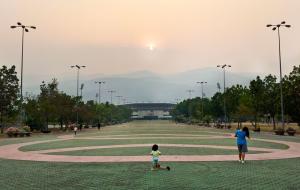Don't know if you've noticed, but burning season's started already. Burning season is the wonderful time of the year when every mountain valley in Northern Thailand heats up to a million degrees and fills with acrid brown smoke. It lasts from late February to mid-May, starting when the cool season ("winter") ends and stays until the rains start. Chiang Mai isn't the only place where this happens - the "Asian brown cloud" also covers parts of India and all of Bangladesh.
But where does the smoke come from? Surprisingly, there's so much debate about this that it's actually become a political issue. There are the obvious causes - Chiang Mai is dry, hot, in a valley and full of diesel trucks - but that doesn't really explain why the pollution here gets five times worse than Bangkok. The government comes up with all sorts of strange explanations (a few years ago they went around shutting down hotpot restaurants), but the standard line is that the smoke is caused by slash and burn agriculture in Burma, Laos and remote areas of Northern Thailand. That's misleading at best.
First off, slash and burn doesn’t refer to farmers burning waste from corn and rice fields. From Wikipedia:
"Slash-and-burn is an agricultural technique which involves cutting and burning of forests or woodlands to create fields. It is subsistence agriculture that typically uses little technology or other tools. It is typically part of shifting cultivation agriculture, and of transhumance livestock herding."
In Southeast Asia slash and burn is used primarily by hill people in remote areas, which is why it's so easy to blame for the smoke. If it's the hill tribes' fault, then there isn't anything the government could do even if they wanted to. (sidenote: states and empires have villified slash and burn for millenia because it's impossible to tax and allows people to live outside the system. The Chinese called it "lazy" and "barbaric" and claiming it's the main source of pollution is just a modern-day excuse to blame everything on minorities)
However, if you've ever been in the countryside around this time of year you'll notice that Thai farmers also burn their fields and there are way more of them than hill tribes. Even though there are laws prohibiting the burning of crops, the police have very little reason to actually do anything about it and there's no infrastructure to dispose of waste any other way.
The majority of the smoke, however, comes from massive, uncontrolled wildfires that sweep through the mountains. Sometimes it's even possible to see them burning on the side of Doi Suthep. Most of these are started accidentally by farmers burning trash, cigarette butts, campfires and the usual, but it's likely that some are intentional. Here's a video.
Why? One reason is that it flushes out game animals for easy pickin', but it also makes it easier to find a certain kind of super-tasty mushroom. The false earthstar (เห็ดเผาะ, het phaw, but usually known by the Northern Thai word เห็ดถอบ, het tawb) is kind of like a tough puffball and totally delicious when boiled and dipped in chili powder. They look exactly like a clump of dirt and live under fallen leaves, so burning off all the underbrush before the rainy season makes them a lot easier to find. People also believe that fires help them grow, but that may or may not be true.
Either way, burning season will continue to get worse until the laws against burning are actively enforced. There are signs on every rural road warning of the dangers, some even threatening 2000 baht fines, yet people continue to burn their trash even in the middle of the city.








